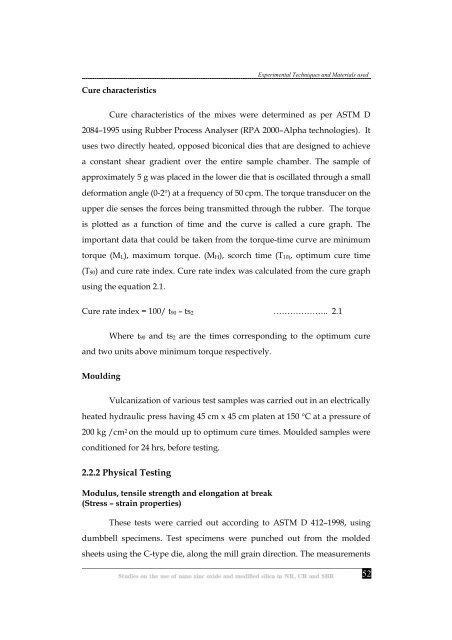Studies on the use of nano zinc oxide and modified silica in NR, CR ...
Studies on the use of nano zinc oxide and modified silica in NR, CR ...
Studies on the use of nano zinc oxide and modified silica in NR, CR ...
You also want an ePaper? Increase the reach of your titles
YUMPU automatically turns print PDFs into web optimized ePapers that Google loves.
Cure characteristics<br />
Experimental Techniques <strong>and</strong> Materials <strong>use</strong>d<br />
Cure characteristics <strong>of</strong> <strong>the</strong> mixes were determ<strong>in</strong>ed as per ASTM D<br />
2084–1995 us<strong>in</strong>g Rubber Process Analyser (RPA 2000–Alpha technologies). It<br />
<strong>use</strong>s two directly heated, opposed bic<strong>on</strong>ical dies that are designed to achieve<br />
a c<strong>on</strong>stant shear gradient over <strong>the</strong> entire sample chamber. The sample <strong>of</strong><br />
approximately 5 g was placed <strong>in</strong> <strong>the</strong> lower die that is oscillated through a small<br />
deformati<strong>on</strong> angle (0-2°) at a frequency <strong>of</strong> 50 cpm. The torque transducer <strong>on</strong> <strong>the</strong><br />
upper die senses <strong>the</strong> forces be<strong>in</strong>g transmitted through <strong>the</strong> rubber. The torque<br />
is plotted as a functi<strong>on</strong> <strong>of</strong> time <strong>and</strong> <strong>the</strong> curve is called a cure graph. The<br />
important data that could be taken from <strong>the</strong> torque-time curve are m<strong>in</strong>imum<br />
torque (ML), maximum torque. (MH), scorch time (T10), optimum cure time<br />
(T90) <strong>and</strong> cure rate <strong>in</strong>dex. Cure rate <strong>in</strong>dex was calculated from <strong>the</strong> cure graph<br />
us<strong>in</strong>g <strong>the</strong> equati<strong>on</strong> 2.1.<br />
Cure rate <strong>in</strong>dex = 100/ t90 – ts2 ……………….. 2.1<br />
Where t90 <strong>and</strong> ts2 are <strong>the</strong> times corresp<strong>on</strong>d<strong>in</strong>g to <strong>the</strong> optimum cure<br />
<strong>and</strong> two units above m<strong>in</strong>imum torque respectively.<br />
Mould<strong>in</strong>g<br />
Vulcanizati<strong>on</strong> <strong>of</strong> various test samples was carried out <strong>in</strong> an electrically<br />
heated hydraulic press hav<strong>in</strong>g 45 cm x 45 cm platen at 150 °C at a pressure <strong>of</strong><br />
200 kg /cm 2 <strong>on</strong> <strong>the</strong> mould up to optimum cure times. Moulded samples were<br />
c<strong>on</strong>diti<strong>on</strong>ed for 24 hrs, before test<strong>in</strong>g.<br />
2.2.2 Physical Test<strong>in</strong>g<br />
Modulus, tensile strength <strong>and</strong> el<strong>on</strong>gati<strong>on</strong> at break<br />
(Stress – stra<strong>in</strong> properties)<br />
These tests were carried out accord<strong>in</strong>g to ASTM D 412–1998, us<strong>in</strong>g<br />
dumbbell specimens. Test specimens were punched out from <strong>the</strong> molded<br />
sheets us<strong>in</strong>g <strong>the</strong> C-type die, al<strong>on</strong>g <strong>the</strong> mill gra<strong>in</strong> directi<strong>on</strong>. The measurements<br />
52

















